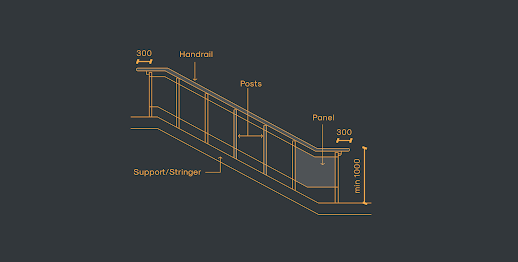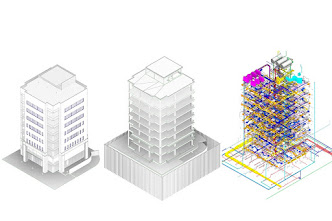Incorporating Safety Features in Steel Staircase and Handrail Design: What You Need to Know - SILICON VALLEY INFOMEDIA PVT. LTD.
When it comes to designing steel staircases and handrails, safety should always be the top priority. Accidents can happen at any time and any place, but a properly designed and constructed staircase and handrail system can minimize the risk of falls and injuries.
To ensure that your steel staircase and handrail design is as safe as possible, there are several key factors to consider. In this blog post, we'll explore these factors and provide you with the information you need to incorporate safety features into your design.
Silicon Valley Infomedia Pvt. Ltd. Handrailing offers Structural Stair Handrail Drawing and Detailing services, working closely with commercial clients to create custom steel staircases that comply with safety regulations. Our services include designing continuous balustrades or barriers for areas without walls or levels exceeding 1m in height. Count on us for accurate and reliable Stair Handrail Detailing services tailored to your business needs.
Before we dive into the safety features you should incorporate into your steel staircase and handrail design, it's important to understand the role of stair handrail shop drawings and,
Structural Stair Handrail Detailing Services are detailed plans that illustrate the design and specifications of your steel staircase and handrail system. These drawings provide a clear visual representation of your design, and they can be used to ensure that your construction team can accurately build the system.
Structural Stair Handrail Detailing Services are typically provided by professional detailing companies that specialize in structural stair handrail detailing services. These companies have the experience and expertise needed to produce high-quality, accurate drawings that will ensure your steel staircase and handrail system is constructed safely and to the highest standards.
Structural Stair Handrail Detailing Services are an essential part of the design process. These services involve creating detailed plans that illustrate the various components of your steel staircase and handrail system, including the dimensions, materials, and specifications.
A skilled stair handrail detailer will take into account a range of factors when creating these plans, including the intended use of the staircase and handrail system, the weight it will need to support, and the available space for installation.
Structural stair handrail drawing services involve the creation of detailed, 3D renderings of your steel staircase and handrail system. These renderings provide a highly accurate representation of the system, and they can be used to identify potential safety issues before construction begins.
When creating these drawings, it's important to consider the size and shape of the staircase and handrail, as well as the location and spacing of handrails and balusters. The renderings should also take into account any obstacles or other features that may impact the safety of the system.
Stair handrail detailer services are typically provided by professional detailing companies that specialize in structural stair handrail design. These companies have the experience and expertise needed to ensure that your steel staircase and handrail system is designed to be as safe as possible.
A skilled stair handrail detailer will take into account a range of factors when designing your system, including the intended use of the staircase and handrail, the weight it will need to support, and the available space for installation. They will also consider the specific safety features that should be incorporated into your design.
Incorporating Safety Features into Your Steel Staircase and Handrail Design Now that you understand the role of stair handrail shop drawings and services, as well as structural stair handrail detailing and drawing services, it's time to consider the safety features you should incorporate into your steel staircase and handrail design.
Handrail Height and Spacing:
One of the most important safety features to consider when designing your steel staircase and handrail system is the height and spacing of the handrails. The handrail should be positioned at a height that is comfortable for users, and it should be spaced no more than 4 inches from the wall or any other obstruction.
Baluster Spacing:
The spacing of the balusters is also an important safety feature to consider. The balusters should be spaced no more than 4 inches apart to prevent individuals from falling through the gaps. This is particularly important if you are designing a staircase or handrail system for a public space or a space that will be used by children.
Handrail Strength:
The strength of the handrail is another critical safety feature to consider. The handrail should be designed to support the weight of individuals using the staircase, as well as any equipment or other items that may be transported up and down the stairs. This is particularly important for commercial or industrial settings, where heavy equipment may need to be transported up and down the staircase.
Slip Resistance:
Slip resistance is another important safety feature to consider when designing your steel staircase and handrail system. The surface of the steps and handrails should be designed to provide adequate grip and prevent individuals from slipping or falling. This is particularly important in settings where the staircase may become wet or slippery due to environmental factors.
Lighting:
Lighting is often overlooked as a safety feature in steel staircase and handrail design, but it can play a critical role in preventing accidents. Adequate lighting should be installed to ensure that the staircase and handrail system is well-lit and visible, particularly in low-light or dark environments.
Proper Installation:
Finally, it's important to ensure that your steel staircase and handrail system is installed properly. This includes ensuring that the system is securely anchored to the building structure and that all components are properly secured and aligned. Improper installation can compromise the safety of the system and increase the risk of accidents and injuries.
Incorporating safety features into your Structural Stair Handrail Detailing Services is critical for ensuring that your system is safe and meets all relevant building codes and regulations. By working with professional stair handrail shop drawings, structural stair handrail detailing, and drawing services, you can ensure that your design is accurate and meets all safety standards.
When designing your Structural Stair Handrail Detailing Services, be sure to consider important safety features such as handrail height and spacing, baluster spacing, handrail strength, slip resistance, lighting, and proper installation. By prioritizing safety in your design, you can create a system that is both functional and safe for users. If you're unsure of how to incorporate these safety features into your design, it's important to consult with professionals who specialize in stair handrail shop drawings, structural stair handrail detailing, and drawing services. These professionals have the expertise and knowledge necessary to ensure that your design meets all safety standards and regulations.
It's also important to keep in mind that safety is not a one-time consideration. Regular inspections and maintenance of your steel staircase and handrail system are critical for ensuring that the system remains safe and functional over time. This includes checking for signs of wear and tear, addressing any damage or issues promptly, and performing routine maintenance tasks such as cleaning and lubrication.
incorporating safety features into your steel staircase and handrail design is essential for creating a safe and functional system. By working with professionals and prioritizing important safety features such as handrail height and spacing, baluster spacing, handrail strength, slip resistance, lighting, and proper installation, you can create a system that meets all safety standards and regulations. Remember to also prioritize regular inspections and maintenance to ensure the ongoing safety and functionality of your system.



Comments
Post a Comment